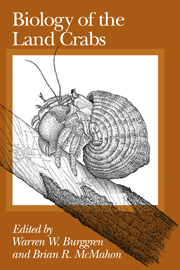Book contents
- Frontmatter
- Contents
- List of contributors
- Preface
- 1 BIOLOGY OF THE LAND CRABS: AN INTRODUCTION
- 2 EVOLUTION, SYSTEMATICS, AND GEOGRAPHICAL DISTRIBUTION
- 3 ECOLOGY
- 4 BEHAVIOR
- 5 REPRODUCTION AND DEVELOPMENT
- 6 GROWTH AND MOLTING
- 7 ION AND WATER BALANCE
- 8 RESPIRATION
- 9 CIRCULATION
- 10 ENERGETICS AND LOCOMOTION
- 11 EPILOGUE
- APPENDIX: Natural histories of selected terrestrial crabs
- References
- Author index
- Systematic index
- Subject index
8 - RESPIRATION
Published online by Cambridge University Press: 04 August 2010
- Frontmatter
- Contents
- List of contributors
- Preface
- 1 BIOLOGY OF THE LAND CRABS: AN INTRODUCTION
- 2 EVOLUTION, SYSTEMATICS, AND GEOGRAPHICAL DISTRIBUTION
- 3 ECOLOGY
- 4 BEHAVIOR
- 5 REPRODUCTION AND DEVELOPMENT
- 6 GROWTH AND MOLTING
- 7 ION AND WATER BALANCE
- 8 RESPIRATION
- 9 CIRCULATION
- 10 ENERGETICS AND LOCOMOTION
- 11 EPILOGUE
- APPENDIX: Natural histories of selected terrestrial crabs
- References
- Author index
- Systematic index
- Subject index
Summary
Introduction
For a majority of animals, obtaining sufficient oxygen (O2) from the atmosphere and delivering it to the tissues, and removing carbon dioxide (CO2) produced as a result of oxidative metabolism, are some of life's paramount tasks. These gases, consumed or produced in the tissues, are carried in the hemolymph and exchanged by diffusion at the body surface, often across areas specialized for this purpose. In the majority of aquatic crustaceans this exchange is an important function of the gills. In the more highly evolved decapod crustaceans, including both the brachyuran and anomuran crabs, these have evolved into complex structures beautifully designed for gas exchange with the aquatic environment. Since air contains approximately 40–60 times more oxygen than water at equivalent temperature and oxygen partial pressure (PO2), one might assume that the gills would continue to function in aerial gas exchange. This, however, is rarely the case. In aquatic crustaceans, and indeed in aquatic animals generally, the gills are designed for aquatic exchange, and they collapse when the buoying effect of water is removed. This reduces the functional surface area available for gas exchange and additionally reduces both perfusion and ventilation of the gills. For most purely aquatic crustaceans, gas exchange in air is thus insufficient and they quickly succumb.
The colonization of land by the decapod crustaceans, as in the vertebrates, thus required the evolution of new structures to allow efficient oxygen uptake from the air. In large part this evolution has involved expansion of the branchial cavity and modification of the branchial epithelium, both of which increase the surface area available for gas exchange.
- Type
- Chapter
- Information
- Biology of the Land Crabs , pp. 249 - 297Publisher: Cambridge University PressPrint publication year: 1988
- 23
- Cited by



